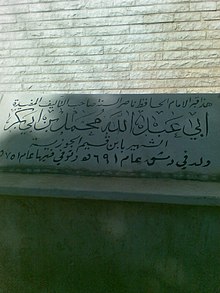Ibn Qaiyim al-Jawzīya
Abū ʿAbdallāh Shams ad-Dīn Muhammad ibn Abī Bakr Ibn Qaiyim al-Jschauzīya, ( Arabic أبو عبد الله شمس الدين محمد بن أبي بكر ابن قيم الجوزية, DMG Abū ʿAbdallāh Šams ad-Dīn Muḥammad b. Abī Bakr Ibn Qaiyim al-Ǧauziya ; born January 29, 1292 near Damascus , Syria ; died September 26, 1350 ) or just Ibn al-Qaiyim , was a well-known Hanbali scholar of the Mamluk period who dealt with theology, Fiqh and Sufism .
He was a student of Ibn Taimiya for 16 years and is one of the people who were received by the so-called Salafism movement. He did not write a Koran - Tafsīr , but currently Tafsīr has been compiled from his various books. Among his disciples were: Ibn Kathir , al-Dhahabi , Ibn Rajab , Ibn Abd al-Hadi and his two sons Ibrahim and Sharaf ad-Din Abdullah.
Ibn al-Qaiyim spoke out often and strictly against the "blind" observance of the schools of law ( madhhab ) and criticized Shiites . He rejected the approach of Islamic school theology ( ʿIlm al-kalām ).
Fonts
- Aḥkām ahl aḏ-ḏimma , basic work, in which he has collected the legal status of the dhimmis according to the Prophet's Sunna and the legal directives of the subsequent generations and commented on it according to the Hanbali doctrine of Fiqh .
- Iʿlām al-muwaqqiʿīn ʿan rabb al-ʿālamīn , a three-volume manual especially for the mufti on Usūl al-fiqh , which follows the principles of Ibn Taimīya.
- Madāriǧ as-sālikīn , a commentary on the Sufi manual Manāzil as-sāʾirīn by Chwadscha ʿAbdallāh al-Ansārī .
- Miftāḥ dār as-saʿāda wa-manšūr wilāyat ahl al-ʿilm wa-l-irāda , collection of reflections on the miraculous arrangement of nature by God, on the Sharia , prophecy and the human need for it, with explanations to refute the Astrology. Ibn Qaiyim's statements in this work about the value of the earth's natural resources are used in today's Islamic environmental movement as evidence that there is an authentic Islamic environmental awareness .
- aṭ-Ṭibb an-nabawī , Treatise on Prophetic Medicine , forms the fourth part of the preceding work.
- ʿUddat aṣ-ṣābirīn wa-ḏaḫīrat aš-šākirīn (“The equipment of the persevering and the supply of those who thank”), here is an excerpt from the translation ( Flash ; 91 kB) * Patience and gratitude , Granada Verlag, Wuppertal 2012
- Zād al-maʿād fī hady ḫair al-ʿibād ("The travel provisions for the hereafter about the guidance of the best of men"), multi-volume work on legal doctrine.
literature
- Carl Brockelmann : History of Arabic Literature. 3 volumes + 2 supplement volumes Leiden: Brill 1938-1949. Vol. II, pp. 127-129, Suppl-Vol. II, pp. 126-128.
- Birgit Krawietz: Hierarchy of Legal Sources in Traditional Sunni Islam. Berlin: Duncker and Humblot 2002. (Writings on legal theory. Volume 208.)
- Birgit Krawietz: Ibn Qayyim al-Jawzīyah: His Life and Works. In: Mamluk Studies Review 10/2 (2006) 19-64. Digitized
- Islamic Theology, Philosophy and Law. Debating Ibn Taymiyya and Ibn Qayyim al-Jawziyya. Edited by Birgit Krawietz and Georges Tamer . Berlin and New York: de Gruyter 2013. (Studies on the History and Culture of the Islamic Orient, Volume 27)
- Henri Laoust : Art. "Ibn Ḳayyim al- Dj awziyya" in The Encyclopaedia of Islam. New Edition Vol. III, pp. 821b-822b.
- Abdul Hakim al-Matroudi: The Hanbali School of Law and Ibn Taymiyyah. Conflict or Conciliation. London: Taylor & Francis 2006. (Culture And Civilization in the Middle East.)
- Miriam Ovadia: Ibn Qayyim Al-Jawziyya and the Divine Attributes. Rationalized Traditionalistic Theology. Leiden: Brill 2018. (Islamic Philosophy, Theology and Science. Texts and Studies, Volume 104.)
supporting documents
- ^ Digitized version of the Dār al-Kutub al-ʿIlmīya edition, Beirut, 1980
- ↑ See M. Izzi Dien: The Environmental Dimensions of Islam . The Lutterworth Press, Cambridge, 2000. pp. 25-27.
| personal data | |
|---|---|
| SURNAME | Ibn Qaiyim al-Jawzīya |
| ALTERNATIVE NAMES | Ibn al-Qayyim Abu Abdullah Shamsid-Din Muhammad Ibn Abu Bakr |
| BRIEF DESCRIPTION | Sunni scholar |
| DATE OF BIRTH | January 29, 1292 |
| PLACE OF BIRTH | near Damascus , Syria |
| DATE OF DEATH | September 26, 1350 |

